Composites Part A: High performance Thermal Conductive Elastomer Composites based on Ti3C2 MXene
QQ Academic Group: 1092348845
Detailed
I. Overview of the article.
In this study, a monolayer Ti3C2 mixed silica filler (Ti3C2-h-SiO2) was proposed to prepare high performance styrene-butadiene rubber (SBR) elastomer composites. It is found that the binding of silica not only promotes the uniform dispersion of Ti3C2-h-SiO2 in SBR matrix, but also gives the nano-protuberances on the surface of Ti3C2-h-SiO2 to fix more rubber chains, thus improving the interfacial interaction between Ti3C2-h-SiO2 and SBR matrix. As a result, the tensile strength of SBR/Ti3C2-h-SiO2 elastomer composites is 174% higher than that of unfilled SBR. In addition, the wet sliding resistance and rolling resistance of SBR/Ti3C2-h-SiO2 elastomer composites have also been significantly improved. It is worth noting that the special thermal conductivity (0.401 W ¡¤m-1 ¡¤k-1) and electrical conductivity (4.87 ¡Á 10-4 S ¡¤m-1) of SBR/Ti3C2-hSiO2 elastomer composites are similar to those of graphene oxide (rGO) elastomer composites reduced by SBR/, which means that the electrical conductivity of Ti3C2-h-SiO2 may be competitive with that of rGO.
Second, guided reading of picture and text.
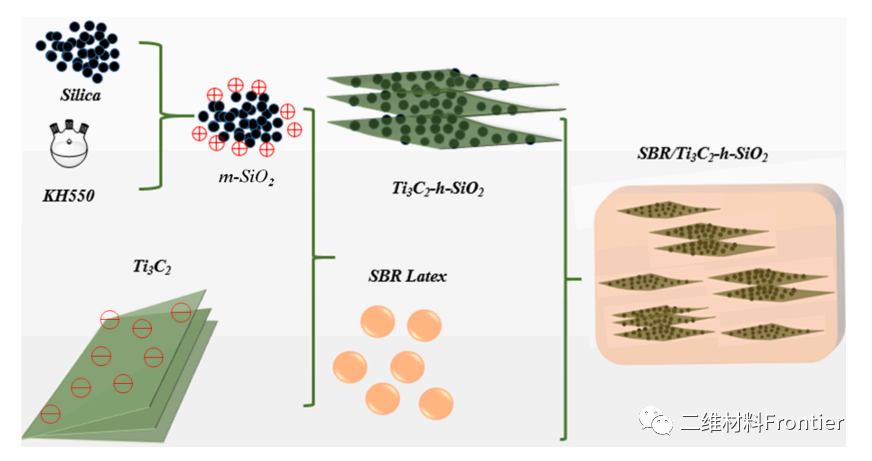
Figure 1.
A schematic diagram of the preparation of SBR/Ti3C2-h-SiO2 elastomer composites.
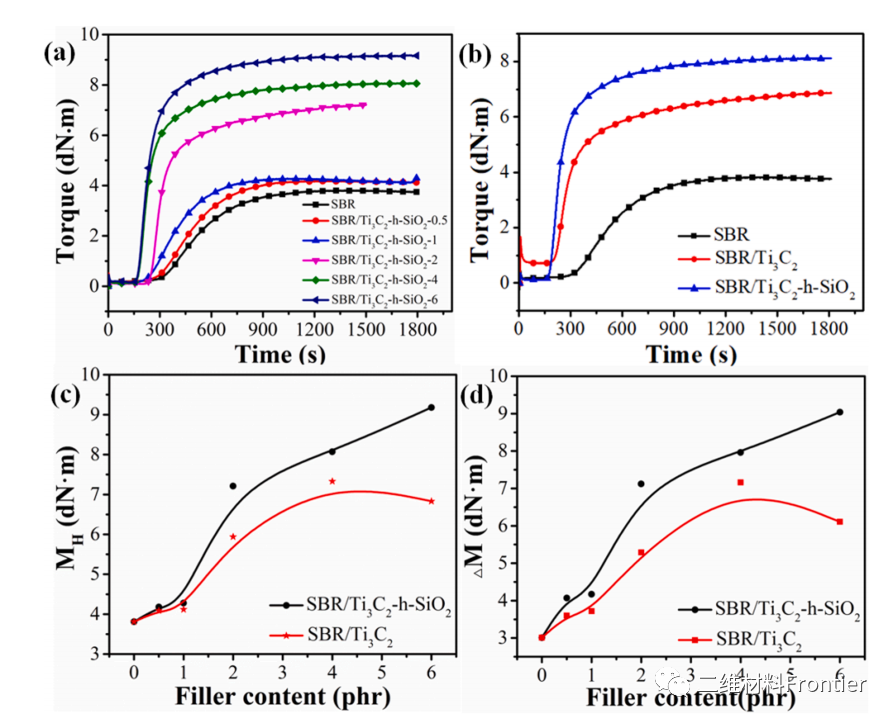
Figure 2.
The property relationship diagram of SBR/Ti3C2-h-SiO2 elastomer composites.
An and b are the vulcanization curves of SBR elastomer composites (the filler content in figure b is 4phr).
C and d are the difference between the maximum torque and the minimum torque (¦¤ M) of (MH) and SBR elastomer composites.
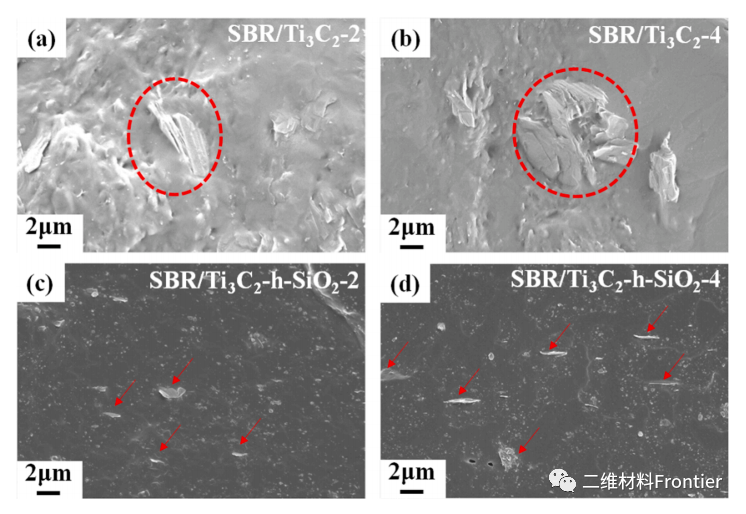
Figure 3.
SEM images of SBR elastomer composites.
An is SBR/Ti3C2- 2, b is SBR/Ti3C2- 4, c is SBR/Ti3C2-h-SiO2-2, d is SBR/Ti3C2-h-SiO2-4.
The results show that Ti3C2 is unevenly distributed in SBR matrix, and as a large aggregate (marked by red ring) (Fig. A), it becomes more and more obvious with the increase of Ti3C2 content (from 2phr to 4phr) (Fig. B), which can inhibit the strengthening effect of Ti3C2 in elastomers in composites. On the contrary, in the SBR/Ti3C2-hSiO2 elastic complex (2phr), the severe aggregation behavior disappeared and Ti3C2-h-SiO2 was well dispersed in the SBR matrix in a monolayer state (Fig. C). Although the content of Ti3C2-h-SiO2 further increased, it remained uniformly dispersed in SBR/Ti3C2-h-SiO2 elastomer composites (4phr) (figure d).

Figure 4.
The DSC curve of SBR elastomer composites in the glass transition region (the filler content is 4phr).
In general, the value of ¦¤ Cpn is closely related to the volume of the immobilized rubber chain, and the decrease of ¦¤ Cpn usually means the decrease of the mobility of the rubber chain during the glass transition. Although the ¦¤ CPN value of SBR elastomer composites is lower than that of unfilled SBR, the ¦¤ CPN value of SBR/Ti3C2-h-SiO2 elastomer composites is the lowest (0.275J g-1 K-1), so the rubber chain immobilized by Ti3C2-h-SiO2 is larger than that of Ti3C2.
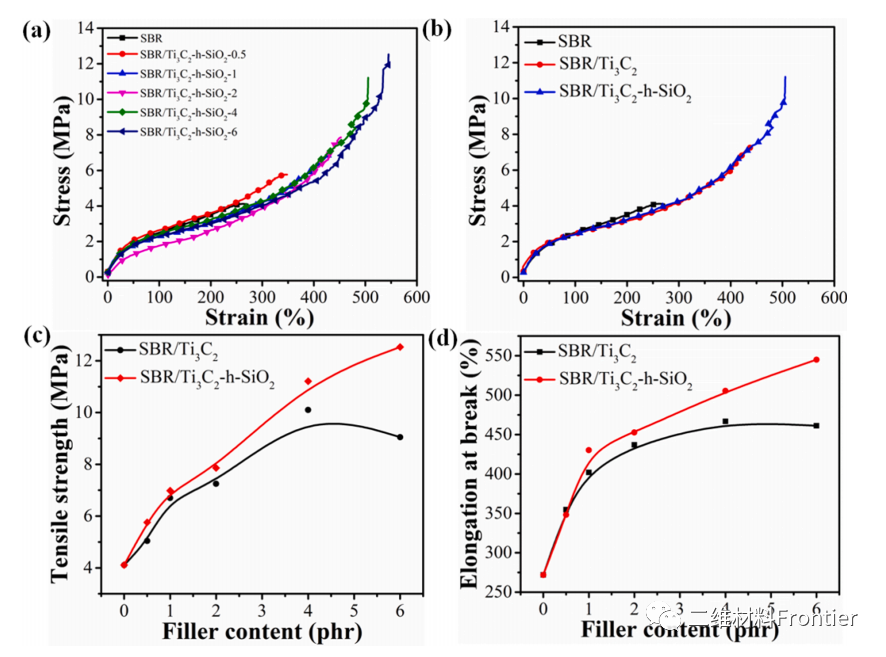
Figure 5.
An and b are the stress-strain curves of SBR elastomer composites (the filler content in figure b is 4phr). C is the tensile strength and the elongation of (d) SBR elastomer composites at fracture.
The stress and strain of SBR/Ti3C2-h-SiO2 elastomer composites increase monotonously with the increase of Ti3C2-h-SiO2 content, which confirms the strengthening effect of Ti3C2-h-SiO2 (figure a). In order to obviously compare the strengthening effects of Ti3C2 and Ti3C2-h-SiO2, the dependence of tensile strength and elongation at break of SBR/Ti3C2 and SBR/Ti3C2-Tih-SiO2 elastic composites was also carried out (figures c and d).
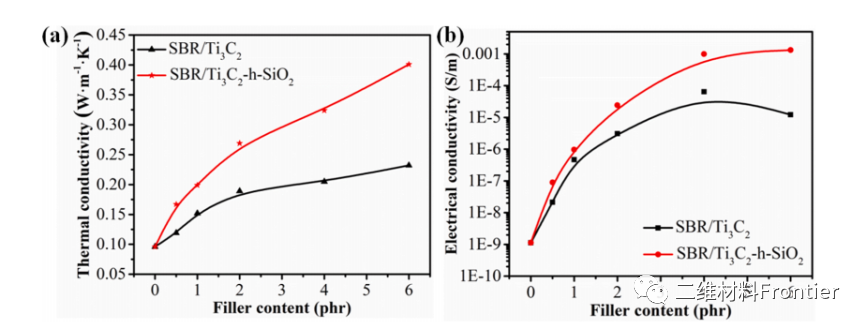
Figure 6.
The thermal properties of (a) and the electrical conductivity of (b) SBR elastomer composites.
As shown in figure a, with the increase of filling amount, the thermal conductivity of SBR elastomer composites increases continuously, which proves that Ti3C2 is an ideal thermal conductive filler, while the thermal conductivity of SBR/Ti3C2 elastomer composites increases slowly. Figure b, first increased to 4 phrases of Ti3C2 content, and then decreased slightly with the further increase of Ti3C2 content. On the contrary, the electrical conductivity of SBR/Ti3C2-h-SiO2 elastic composites increased monotonously with the increase of Ti3C2-h-SiO2 content, which was always higher than that of SBR/Ti3C2 elastic composites, which proved that the electrical conductivity of SBR matrix given by Ti3C2-h-SiO2 was better than that of Ti3C2.
III. Summary of the full text.
A new type of monolayer mixed filler Ti3C2-h-SiO2, was successfully synthesized by electrostatic self-assembly method and applied to a kind of high performance thermal conductive SBR elastomer composites. The addition of silica is very important for Ti3C2 to play an important role in SBR elastomer composites. On the one hand, the presence of silica promotes the uniform dispersion of Ti3C2-h-SiO2 in SBR matrix and improves the interface interaction between Ti3C2-h-SiO2 and SBR matrix. On the other hand, the nano-protuberances of silica on the surface of Ti3C2-h-SiO2 help to fix the rubber chain, promote the curing process, and enhance the cross-linking density of SBR elastomer composites. Based on the above advantages, the mechanical properties of SBR/Ti3C2-h-SiO2 elastomer composites have higher wet slip properties and lower rolling properties.Considering the special thermal and electrical conductivity of SBR/Ti3C2-hSiO2 elastomer composites, it may have more opportunities to be candidates in advanced fields, such as biomedical devices and soft robots.
This information is from the Internet for academic exchange only. if there is any infringement, please contact us to delete it immediately.
- Previous£º Bi2S3/Ti3C2Tx MXene in
- Next£º A Rising 2D Star: Nove


 Academic Frontier
Academic Frontier